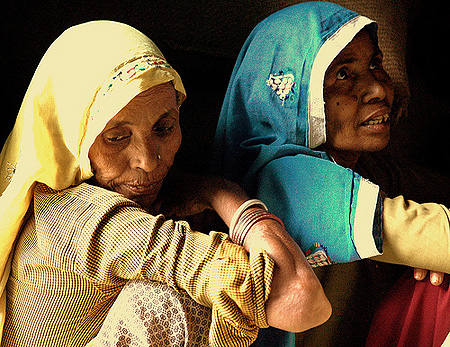|
Ageing India May
See a Rise in Number of Widows: WHO
By
Kounteya Sinha, The Times of India
April
3, 2012
India

NEW DELHI: The World
Health Organization (WHO) on Monday warned India that feminization of
its ageing population could lead to a rapid increase in its number of
widows.
Reacting to a TOI story that showed how the majority of India's elderly
are now women, WHO's representative to India Dr Nata Menabde said the
trend has significant consequences for the health of older women.
She said, "Women's longer life-spans compared to men, combined with the
fact that men tend to marry women younger than themselves, mean that
the number of widows will increase rapidly."
She added, "Being a male-dominated society and given the fact that
women in India rely on their husbands for the provision of economic
resources and social status, a large percentage of older women are at
risk of dependency, isolation, and/or dire poverty and neglect."
According to her, a quarter of the global elderly population will be in
India by 2015, and the elderly population in India will be more than
12% of the total population by 2026.
The Registrar General of India's latest data from the Sample
Registration System, 2010, had found that the percentage of women in
the age bracket of 60 years and above is higher in 17 out of the 20
large states.
Dr Menabde said that a further consequence of differential life
expectancy "is that there are more women especially among the oldest
old, those 85 years and above. Given that disability rates rise with
age, this means that there are substantially number of older women than
older men living with disabilities."
WHO says that women have higher chances of getting excluded from
various social security programmes due to lower literacy and gender
issues.
"Women's labour in developing countries is concentrated in the
informal, agricultural and service sectors. Older women have less
access to social protection such as health insurance, which has a
cumulative negative effect over a woman's lifespan and can seriously
affect their health in old age," Dr Menabde added.
She suggested that the government should consider bringing in a state
sponsored insurance policy just for the old. With 30% of India's
elderly being below the poverty line, Dr Menabde spoke about the
provision for services for BPL families and elderly population under
the National Programme for Healthcare of Elderly that is being rolled
out in 100 districts.
Between 1980 and 1985, the life expectancy for women in India was lower
than that of men due to high maternal mortality, discrimination against
women in nutrition and access to healthcare. As the conditions
improved, the life expectancy of women has become higher than that of
men.
From 2001 to 2005, the life expectancy of women was 66.1 years as
compared to 63.8 years for men.
"Due to higher life-expectancy among women, it was expected that the
population of women will take over the population of men," she added.
Dr Menabde said, "Indian hospitals must provide services which are
age-friendly including a separate geriatric department. Wherever a
separate department is not possible, separate queues/windows may be
provided. There should be provision for free/subsidized medicines
especially for elderly in BPL families. Ramps and chairs for disabled
may be provided."
WHO said nearly 142 million people in the south-east Asia region are
above the age of 60 years. The number of aged people will double by
2025, and triple by 2050 compared to 2000. The average life expectancy
in most countries in the region will be above 75 years by 2050.
Overall, nearly 7.5% of India's population is aged 60 years and above.
In rural India, 7.5% people are aged 60+, while in urban India the
corresponding figure is 7%.
According to the 2006 World Population Prospects, India's 80+ will
increase more than six times from existing 78 lakh to about 5.14 crore
by 2050. Now, 20% of this category in India suffers from Alzheimer's
disease. The 65+ population is expected to quadruple from 6.4 crore in
2005 to 23.9 crore, while those aged 60 and above will increase from
8.4 crore to 33.5 crore over the next 43 years.
Copyright © Global Action on Aging
Terms of Use
| Privacy Policy
| Contact Us
|



